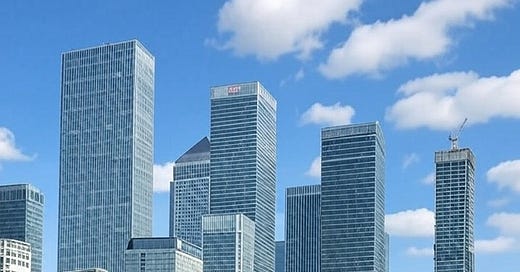With the recent retirement of Sir George Iacobescu, the visionary who transformed Canary Wharf into an icon of modernity, now is the perfect time to celebrate this ambitious project as an inspiring example of a city within Europe. More than just a financial district in London, Canary Wharf embodies bold ideas that could shape the future of urban living: from the spirit of ancient Greek poleis to concepts like independent anarcho-capitalist cities, free zones, and private cities.
This article explores, from an optimistic perspective, how Canary Wharf has not only redefined London’s landscape but also offers a promising model for the European cities of tomorrow.
A Visionary Legacy: George Iacobescu and the Reinvention of Canary Wharf
Sir George Iacobescu, who led the development of Canary Wharf for 36 years, turned a derelict docklands area in east London into a thriving financial hub that rivals the City. Under his leadership, the Canary Wharf Group (CWG) created a “city within a city,” a space with over 120,000 jobs, 16.5 million square feet of office and retail space, and an infrastructure that includes transport, security, and privately managed public spaces. His retirement marks the end of an era but also the beginning of a new phase for this project, which remains a testament to the power of vision and private investment.From an optimistic perspective, Iacobescu’s legacy is not just a successful district but proof that cities can be reborn and thrive when bold leadership, innovation, and public-private collaboration converge. Canary Wharf is a blank canvas that invites us to imagine how Europe could build its future metropolises.
A Modern Polis: Autonomy and Identity
In ancient Greece, poleis were independent city-states, each with its own government, economy, and culture. While Canary Wharf is not a sovereign entity, it shares with the poleis a functional autonomy and a distinct identity. This district, with its gleaming skyscrapers and vibrant business ecosystem, operates as a hub of activity within London, attracting global companies and international talent.The idea of a modern polis is deeply optimistic: it suggests that cities can be more than amorphous extensions of a capital. They can be specialized hubs with their own character, like Athens or Sparta in their time. Canary Wharf shows that it’s possible to create urban spaces that function as independent economic and cultural engines, integrated yet unique within a broader context. For Europe’s future, this opens the door to a network of modern poleis, each shining with its own purpose and personality.
The Anarcho-Capitalist Dream: Innovation Without Borders
Anarcho-capitalism advocates for societies where the state plays a minimal role, and the free market and private property govern. While Canary Wharf is not an anarcho-capitalist city in the purest sense, its privately led development—with the Canary Wharf Group making key decisions on planning, security, and maintenance—reflects this philosophy in action. This approach has enabled a speed and flexibility that state-led projects rarely achieve.From an optimistic viewpoint, Canary Wharf shows how private management can be a transformative force. Imagine future cities where visionary companies work alongside communities to build spaces that respond nimbly to market and societal needs. Far from utopian, this model has already proven its worth in Canary Wharf, suggesting that Europe could embrace bolder versions of independent cities that prioritize innovation and economic freedom.
Free Zones: A Magnet for Prosperity
Free zones are areas with relaxed economic regulations to encourage trade and investment. While Canary Wharf is not a traditional free zone, its success stems from a business-friendly environment, supported by government incentives like the extension of the Jubilee line. This balance of public support and private dynamism has made the district a magnet for global finance, similar to free zones like Dubai.The optimism here lies in the replicable potential of this approach. European cities could establish their own “urban free zones,” designed to attract specific industries—tech in Berlin, design in Milan, renewables in Copenhagen. Canary Wharf illustrates how such zones can become catalysts for growth, uplifting not just their residents but the entire surrounding region.
Private Cities: The Future Made Real
Private cities, managed by non-governmental entities with their own rules, are an emerging concept. Canary Wharf comes close to this idea with its private management and focus on efficiency and quality of life for those who work and live there. Its public spaces, while accessible, are carefully curated by the CWG, ensuring an orderly and attractive environment.From an optimistic perspective, this is exciting: private cities could be laboratories for urban innovation, free from traditional bureaucratic constraints. In the future, Europe could see more districts like Canary Wharf emerge, where private management creates sustainable, technologically advanced, and economically vibrant communities. These cities would not only be livable but desirable, attracting the world’s brightest minds.
A Bright Future for Europe
The Canary Wharf model has already inspired similar projects in Europe, such as HafenCity in Hamburg or La Défense in Paris, but its scale and speed make it unique. Looking forward, this district suggests a future where European cities embrace a mix of autonomy, private investment, and economic specialization. Imagine a Europe dotted with dynamic urban hubs—modern poleis—that blend the best of private management and public welfare.Challenges like equity and sustainability are not obstacles but opportunities to refine this model. Canary Wharf is already advancing with initiatives like green spaces and 5G technology, showing it can adapt to 21st-century demands. With the post-pandemic transition and new work trends, the district is well-positioned to remain relevant, as Iacobescu himself emphasized by highlighting the importance of physical spaces for collaboration.
A Model for Dreaming Big
Canary Wharf is not just a past achievement; it’s a promise for the future. George Iacobescu’s retirement marks a milestone but also an invitation to imagine how Europe can build cities that combine the independence of Greek poleis, the freedom of anarcho-capitalist ideas, the vitality of free zones, and the efficiency of private cities. From this optimistic perspective, Canary Wharf is not an endpoint but a beginning—a beacon lighting the way toward an urban renaissance full of possibilities for the continent.











Share this post